Blockbuster! Ministry of Housing "14th Five-Year" Building energy Conservation and Green Building Development Plan "released!
Release Time : 2022-03-16 16:05:50Source: Ministry of Housing and Urban-Rural Development of the People's Republic of China
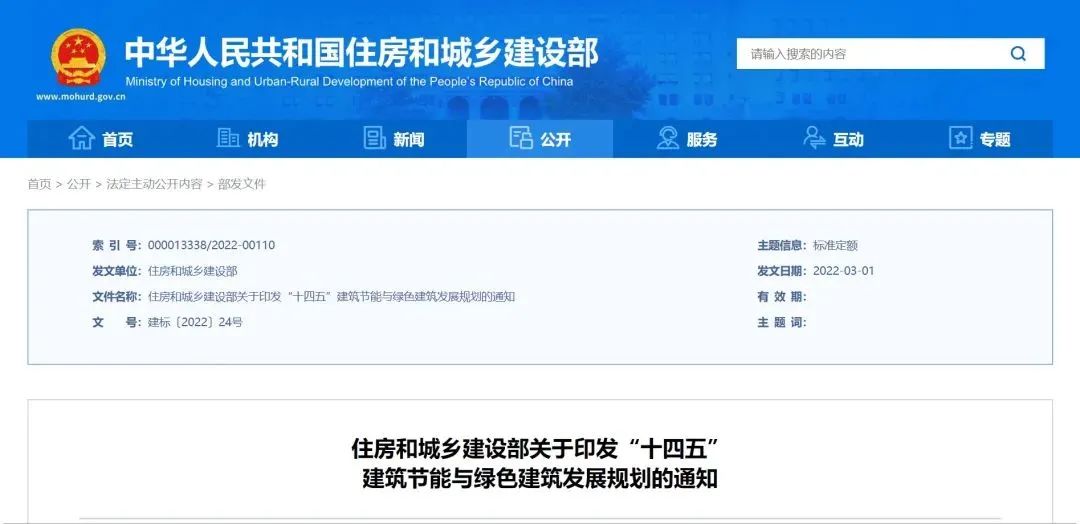
"14th Five-Year Plan for Building Energy Efficiency and Green Building Development"
Highlights:
The Ministry of Housing and Urban-Rural Development officially "14th Five-Year Plan" building energy efficiency and Green building development Plan, proposed that by 2025, the existing building energy efficiency renovation area of more than 350 million square meters, the construction of ultra-low energy consumption, near zero energy consumption buildings more than 50 million square meters.
Promote New Green Construction Methods
We will actively promote prefabricated concrete buildings in commercial housing and affordable housing, improve the structural system of prefabricated concrete buildings suitable for different building types, and increase the integrated application of high-performance concrete, high-strength steel bars, energy dissipation and shock absorption and prestress technologies. The development of wooden structures in accordance with local conditions. Promote mature and reliable new green construction technologies. Improve the standardized design and production system of prefabricated buildings, promote design selection and integrated design, promote fewer specifications and multiple combination design methods, promote the standardization of components and parts, expand the scale of use of standardized components and parts, and meet the requirements of standardized design selection. Actively develop assembly decoration, promote pipeline separation, integrated decoration technology, improve the quality of decoration.
We Will Promote The Application of Green Building Materials
Increase investment in research and development of green building materials products and key technologies, promote high-strength steel bars, high-performance concrete, high-performance masonry materials, structural insulation integrated wall panels, etc., and encourage the development of prefabricated components and components with excellent performance. Take the lead in adopting green building materials in government-invested projects, and significantly increase the proportion of green building materials used in new urban buildings. Optimize the selection of materials to improve the health performance of buildings, carry out research on the integrated selection technology of green building materials products aimed at improving the use function of buildings, and promote new functional environmental protection building materials products and supporting application technologies.
Here is the full text:
In order to further improve the level of building energy conservation during the "14th Five-Year Plan" period and promote the high-quality development of green buildings, This plan is formulated in accordance with the 14th Five-Year Plan for National Economic and Social Development of the People's Republic of China and the Outline of the 2035 Vision Goals, the Opinions of the Central Committee of the Communist Party of China and The State Council on Fully, Accurately and Comprehensively Implementing the New Development Concepts to Achieve Carbon Peak and Carbon Neutrality, the Opinions of the General Office of the Central Committee of the Communist Party of China and The General Office of the State Council on Promoting the Green Development of Urban and Rural Construction and other documents.
一、Development Environment
(一)Development Basis。
During the "13th Five-Year Plan" period, China's building energy conservation and green building development has made significant progress. Green buildings have achieved leapfrog development, laws and standards have been continuously improved, identification and management have been gradually standardized, and the construction scale has grown rapidly. Energy efficiency standards for new urban buildings have been further improved, the scale of construction of ultra-low energy consumption buildings has continued to grow, and near-zero energy consumption buildings have achieved zero breakthroughs. Progress has been made in improving the energy efficiency of public buildings, new progress has been made in building key cities, and initial progress has been made in building market-based mechanisms such as contract energy management. Steady progress was made in upgrading existing residential buildings to conserve energy, and research on upgrading rural housing to conserve energy continued to deepen. The scale of renewable energy applications continues to expand, the installed capacity of solar PV continues to increase, and the replacement rate of renewable energy gradually increases. Prefabricated buildings have developed rapidly, policies have been continuously improved, and demonstration cities and industrial bases have played an obvious leading role. Steady progress was made in the evaluation, certification and promotion of green building materials, and government procurement continued to support pilot projects for green buildings and green building materials applications.
During the "13th Five-Year Plan" period, the energy efficiency of new residential buildings in cities and towns in cold and cold areas reached 75%, and the total construction area of ultra-low and near-zero energy consumption was nearly 0.1 million square meters, the energy-saving renovation area of existing residential buildings was 514 million square meters, and the energy-saving renovation area of public buildings was 185 million square meters, and the renewable energy substitution rate of urban buildings reached 6%. By the end of 2020, the proportion of new green buildings in urban areas that year had reached 77 percent, the total green building area had exceeded 6.6 billion square meters, the total energy-saving building area had exceeded 23.8 billion square meters, and the proportion of energy-efficient buildings in urban civil building area had exceeded 63 percent. The newly started prefabricated buildings accounted for 20.5% of the new construction area in cities and towns that year. The work tasks determined by The State Council and the goals of the "13th Five-Year Plan" building energy conservation and green building development plan were successfully completed.
(二)Development Situation。
The "14th Five-Year Plan" period is the first five years to start a new journey to comprehensively build a modern socialist country, and is a key period to implement the goal of carbon peak by 2030 and carbon neutrality by 2060. Building energy efficiency and green building development face greater challenges, but also usher in important development opportunities.
Carbon Peak Carbon neutral goal vision puts new requirements. The Opinions of the CPC Central Committee and The State Council on Fully, Accurately and Comprehensively Implementing the New Development Concepts to achieve carbon Peak and Carbon Neutrality and the Action Plan for Achieving Carbon Peak Before 2030 of The State Council have clarified the task requirements for reducing carbon emissions in the field of urban and rural construction. Building carbon emissions are the focus of carbon emissions in the field of urban and rural construction. Improving building energy efficiency standards, implementing energy-saving renovation of existing buildings, optimizing building energy structure, and promoting building carbon emissions to peak as soon as possible will make positive contributions to the realization of carbon peak carbon neutrality in China.
Green development in urban and rural development brings new opportunities. The "Opinions of the General Office of the CPC Central Committee and The General Office of the State Council on Promoting Green Development in Urban and Rural Construction" defines the blueprint for green development in urban and rural construction. By accelerating the construction of green buildings, changing the construction method, actively promoting green building materials, promoting efficient and low-carbon building operation and management, and realizing green and low-carbon development during the whole life of buildings, it will greatly promote the green development of urban and rural construction.
New impetus has been injected into the people's aspiration for a better life. With the improvement of the level of economic and social development, the people's demand for a better living environment is getting higher and higher. By promoting the development of building energy conservation and green buildings, providing people with better public services, more beautiful working and living space, and more perfect building functions with less energy and resources consumption, it will continuously enhance people's sense of gain, happiness and security while reducing carbon emissions.
二、General Requirement
(1) Guiding ideology.
Based on the green development of urban and rural construction, improve the quality of green and low-carbon development of buildings, reduce the consumption of building energy and resources, change the development mode of urban and rural construction, and lay a solid foundation for the realization of carbon peak in urban and rural construction by 2030.
(2) Basic Principles.
-- Green development and harmonious coexistence. Adhere to the concept of harmonious coexistence between man and nature, build high-quality green buildings, improve the safety, health, livable, convenient and economical performance of buildings, and improve people's well-being.
-- Focus on peaking and reducing emissions. Focus on the goal of peaking carbon in urban and rural construction before 2030, improve the level of building energy efficiency, optimize the energy use structure of buildings, and reasonably control the total energy consumption and carbon emissions in the construction sector.
-- Making overall plans in light of local conditions. According to the regional development strategy and local development goals, determine the overall requirements and tasks of building energy efficiency and green building development, take urban and rural areas as units, take into account new buildings and existing buildings, and form a development pattern with regional characteristics.
-- Two wheel drive, two hands power. We will improve government guidance and market participation mechanisms, increase policy guidance in planning, standards and finance, encourage market players to participate, regulate their behavior, make the market an important force in promoting green and low-carbon development of buildings, and further improve the quality and efficiency of building energy conservation and green building development.
-- Led by science and technology and driven by innovation. Focusing on the needs of green and low-carbon development, we will build a market-oriented technological innovation system with enterprises as the main body and deep integration of industry, universities and research institutes. We will strengthen technological research, make up for technical weaknesses, pay attention to international technological cooperation, and promote building energy conservation and green building innovation and development in China.
(3) Development goals
1. Overall goal. By 2025, new buildings in cities and towns will be fully built into green buildings, building energy utilization efficiency will be steadily improved, building energy consumption structure will be gradually optimized, building energy consumption and carbon emission growth trends will be effectively controlled, and a green, low-carbon and circular construction and development mode will be basically formed, laying a solid foundation for carbon peaking before 2030 in the field of urban and rural construction.
Box 1 Overall indicators of building energy efficiency and green building development during the 14th Five-Year Plan period

(Note: The indicators in the table are all expected indicators)
2. Specific goals. By 2025, more than 350 million square meters of energy-saving renovation of existing buildings will be completed, more than 500 million square meters of ultra-low energy consumption and near-zero energy consumption buildings will be built, the proportion of prefabricated buildings in new urban buildings will reach 30%, the installed capacity of solar photovoltaic in new buildings nationwide will be more than 500 million kilowatts, the application area of geothermal energy buildings will be more than 100 million square meters, the renewable energy replacement rate of urban buildings will reach 8%, and the proportion of electricity consumption in building energy consumption will exceed 55%.
Box 2 Specific indicators for the development of building energy efficiency and green buildings during the 14th Five-Year Plan period
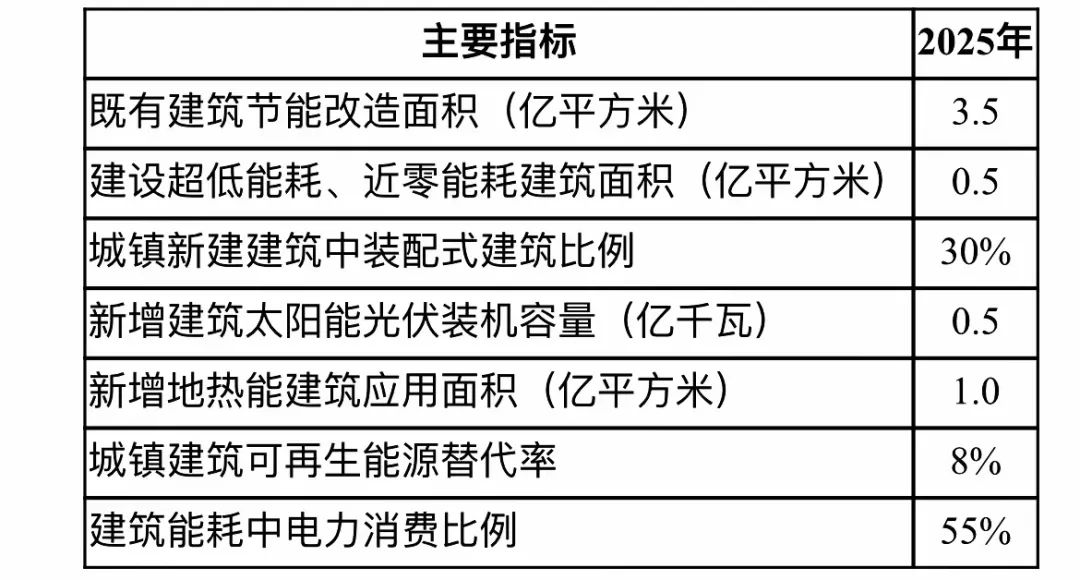
(Note: The indicators in the table are all expected indicators)
3. Key tasks
(1) Improve the quality of green building development.
1. Strengthen the construction of high-quality green buildings. Promote the implementation of green building standards, and strengthen planning, design, construction and operation management. Advocate the concept of green and low-carbon building design, make full use of natural ventilation and natural lighting, reduce the energy intensity of residential buildings, and improve the health performance of residential buildings. Promote the construction of star-rated green buildings in all new buildings such as public welfare buildings and large-scale public buildings invested by the governments of qualified areas. Guide local governments to formulate supporting policies, promote the large-scale development of green buildings, and encourage the construction of high-star green buildings. Reduce the incidence of common problems in project quality and improve the quality of green building projects. Carry out pilot projects for the construction of green farmhouses.
2. Improve the operation and management system of green buildings. Strengthen the operation and management of green buildings, improve the operation efficiency of green building facilities and equipment, and incorporate the daily operation requirements of green buildings into the property management content. Establish a green building user evaluation and feedback mechanism, regularly carry out green building operation evaluation and user satisfaction surveys, and continuously optimize and improve the level of green building operation. Encourage the construction of intelligent operation and management platforms for green buildings, make full use of modern information technology, and realize real-time monitoring and statistical analysis of building energy and resource consumption, indoor air quality and other indicators.
Box 3 Key projects for the development of high-quality green buildings

(2) Improve the level of energy conservation in new buildings.
Based on the energy-saving index requirements determined by the General Code for Building Energy Conservation and Renewable Energy Utilization, the implementation of the "small steps and fast running" improvement plan for the energy efficiency of new civil buildings in China was launched, and the mandatory standards for energy conservation of new civil buildings in cities and towns were improved in stages, types and climate zones, focusing on improving the energy-saving performance requirements of key components such as building doors and windows, and promoting building thermal insulation systems with strong regional adaptability, high fire rating and good thermal insulation performance. Promote government investment in public welfare buildings and large public buildings to improve energy-saving standards, and strictly control the construction of high-energy-consuming public buildings. Guide key regions such as Beijing-Tianjin-Hebei and the Yangtze River Delta to formulate higher-level energy-saving standards, carry out large-scale construction of ultra-low-energy buildings, and promote the construction of zero-carbon buildings and zero-carbon communities. In other regions, we will carry out demonstrations of ultra-low energy buildings, near-zero energy buildings, and zero-carbon buildings. Promote the implementation of relevant standards for rural housing and rural public buildings, promote appropriate energy-saving technologies, and build a number of pilot demonstration projects for ultra-low energy consumption rural buildings, so as to improve the energy utilization efficiency of rural buildings and improve the indoor thermal and comfortable environment.
Box 4 Key projects for improving energy-saving standards for new buildings
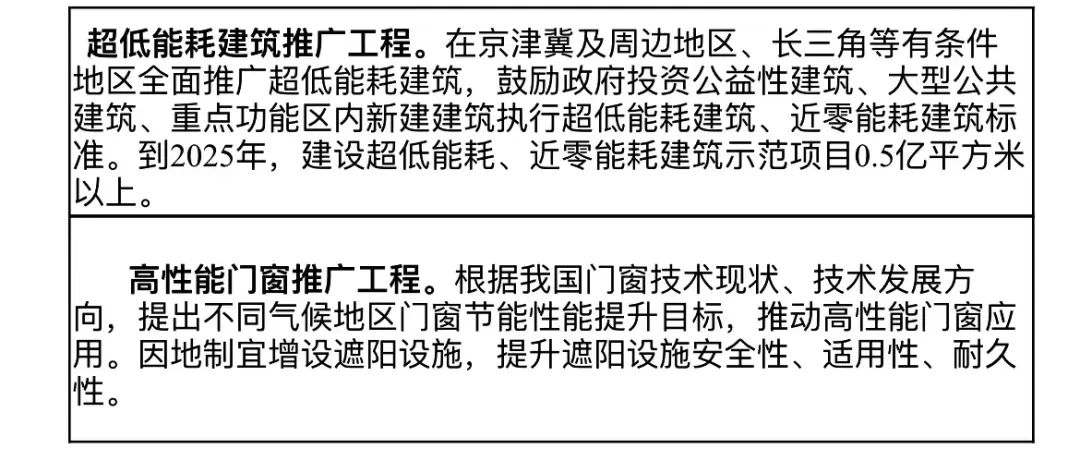
(3) Strengthen the energy-saving and green transformation of existing buildings.
1. Improve the energy efficiency level of existing residential buildings. Except for illegal buildings and buildings that have been identified as dangerous buildings and have no repair and retention value, the existing buildings shall not be demolished on a large scale and in a concentrated manner. In severe cold and cold areas, combined with the clean heating work in the northern region in winter, we will continue to promote the transformation of energy efficiency improvement on the user side of buildings, the insulation of heating pipe networks and the transformation of intelligent regulation and control. In areas with hot summers and cold winters, to meet the needs of residents for heating, air conditioning, ventilation and other needs, actively carry out energy-saving renovation of existing residential buildings, and improve the energy efficiency and indoor comfort of buildings. In the renovation of old urban communities, we should encourage the strengthening of energy-saving renovation of buildings, and form an energy-saving, low-carbon, and livable comprehensive transformation model that is coordinated with the improvement of the public environment in the community, the renovation of facilities suitable for the elderly, and the improvement and transformation of infrastructure and building use functions. Guide residents to purchase energy-efficient products when replacing parts and equipment such as doors and windows, air conditioners, and wall-hung boilers.
2. Promote the energy-saving and green transformation of existing public buildings. Strengthen the construction of the supervision system for the operation of public buildings, coordinate the analysis and application of data and information such as energy consumption statistics, energy audits, and energy consumption monitoring, carry out pilot projects for the publicity and disclosure of energy consumption information, and generally improve the level of energy-saving operation of public buildings. Guide all localities to formulate energy (electricity) quota indicators for public buildings by category, carry out building energy consumption comparison and energy efficiency evaluation, and gradually implement energy management for public buildings. We will continue to promote the construction of key cities to improve the energy efficiency of public buildings, and strengthen the transformation of energy-using systems and envelopes. Promote the application of building facilities and equipment optimization control strategies, improve the efficiency of heating and air conditioning systems and electrical systems, accelerate the popularization of LED lighting fixtures, and use elevator intelligent group control and other technologies to improve elevator energy efficiency. Establish a system for the operation and adjustment of public buildings, promote the regular operation adjustment of energy-using equipment in public buildings, and improve the level of energy efficiency.
Box 5 Key projects for energy-saving renovation of existing buildings

(4) Promote the application of renewable energy.
1. Promote the application of solar energy in buildings. According to the conditions of solar energy resources, building utilization conditions and energy demand, the building application of solar photovoltaic and solar thermal system should be coordinated. Promote the integrated design, construction and installation of solar photovoltaic in new buildings, and encourage the government to invest in public welfare buildings to strengthen the application of solar photovoltaic. If building photovoltaic is installed, the structural safety and fire safety of the building or facility should be ensured, and the potential of installing solar photovoltaic systems on the roof, walls, ancillary facilities and municipal utilities of the building should be assessed in advance. The building solar photovoltaic system should have the ability to immediately cut off the power and enter a non-dangerous state, and should be firmly connected with the building body to ensure no water leakage and no water seepage. PV systems that do not meet safety requirements should be deactivated immediately, and abandoned building solar PV systems must be dismantled in a timely manner. Carry out regional-level photovoltaic distributed application demonstrations with smart photovoltaic systems as the core and new technologies such as energy storage and building power demand response as the carriers. Actively promote solar thermal technology in public buildings with stable hot water demand, such as urban hotels, schools, and hospitals. Actively promote appropriate technologies such as passive solar houses in rural areas.
2. Strengthen the use of renewable energy such as geothermal energy. Promote the application of geothermal energy, air thermal energy, biomass energy, etc. to solve the energy needs of building heating, domestic hot water, cooking, etc. Encourage all localities to promote the use of ground source heat pump technology according to local conditions according to geothermal energy resources and building needs. For the Yangtze River basin and other areas with abundant surface water resources, actively develop surface water source heat pumps, and steadily promote underground water source heat pumps on the premise of ensuring 100% recharge. Under the condition of satisfying the cold and heat balance of soil and not affecting the development and utilization of underground space, the shallow soil source heat pump technology should be promoted. On the basis of resource assessment and environmental impact assessment, the development and utilization of medium and deep geothermal energy should be carried out by cascade utilization. Actively promote the application of air thermal heat pump technology in cold areas, hot summers and cold winters, and carry out ultra-low temperature air source heat pump technology and product applications in severe cold areas. Rational development of biomass heating.
3. Strengthen the construction and management of renewable energy projects. Encourage all localities to carry out surveys of renewable energy resource conditions and building utilization conditions, prepare implementation plans for renewable energy building applications, and determine renewable energy application targets, project layouts, appropriate promotion technologies and implementation plans for renewable energy applications in the region。 Establish a normalized supervision and inspection mechanism and a post-evaluation system for renewable energy building application projects, and continuously adjust and optimize the operation strategy of renewable energy building application projects based on the assessment results, so as to achieve efficient application of renewable energy。 Continuously monitor the environmental impact of large-scale renewable energy application projects to ensure the sustainable development and utilization of renewable energy.
Box 6 Key projects for the application of renewable energy
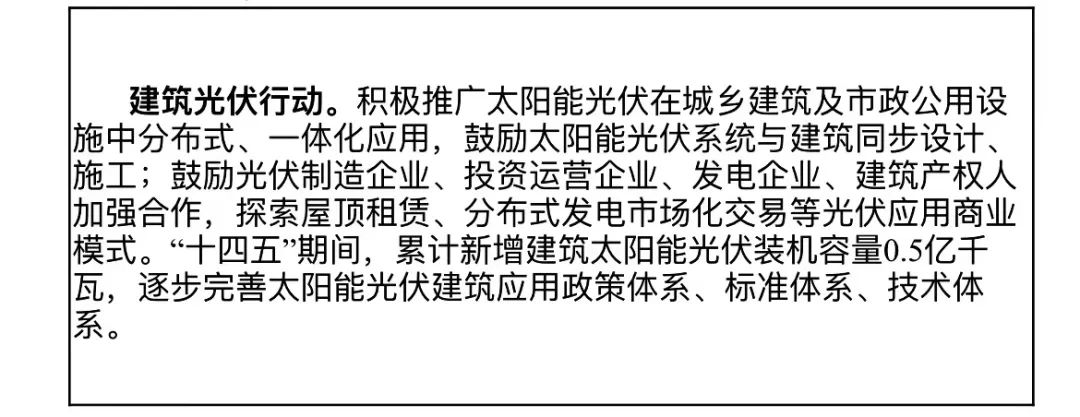
(5) Implement building electrification projects.
Give full play to the advantages of cleanliness, availability and convenience of electricity consumption in the building terminal, and establish a building energy consumption system with electricity consumption as the core. In areas with hot summers and cold winters, electric heating methods such as heat pumps are actively used to solve the new heating demand. Carry out pilot demonstrations of all-electric design of new public buildings. Promote the application of heat pumps, electric cold storage air conditioners, and heat storage electric boilers in large shopping malls, office buildings, hotels, airport terminals and other buildings in the city. Guide the development of domestic hot water and cooking energy to electrification, and promote the R&D and application of high-efficiency electrification technology and equipment. Encourage the construction of a new type of building power system characterized by "light, storage, direct and flexible", and develop flexible electricity buildings.
Box 7 Key projects of building electrification
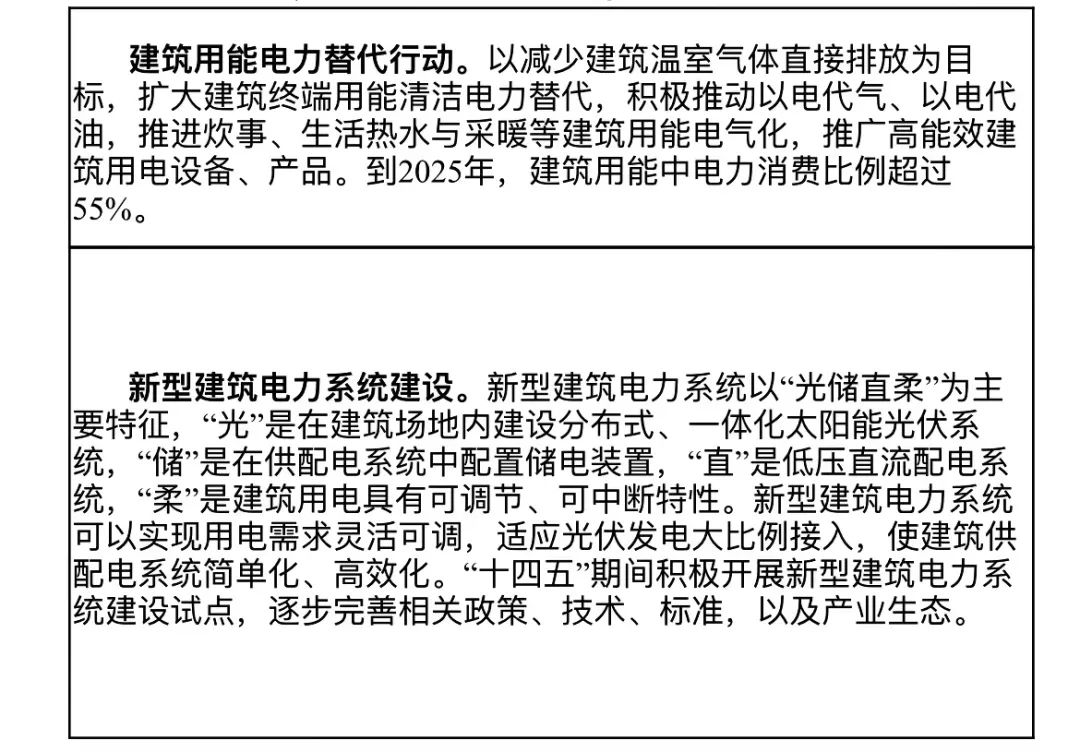
(6) Promote new green construction methods.
Vigorously develop steel structure buildings, encourage hospitals, schools and other public buildings to give priority to the use of steel structure buildings, actively promote the construction of steel structure housing and farmhouses, and improve the performance and technical measures of steel structure buildings such as fire prevention and anti-corrosion. Actively promote prefabricated concrete buildings in commercial housing and affordable housing, improve the prefabricated concrete building structure system suitable for different building types, and increase the integrated application of high-performance concrete, high-strength steel bars, energy dissipation and shock absorption, and prestressing technology. Develop timber buildings according to local conditions. Promote new and reliable green construction technologies that are mature and reliable. Improve the standardized design and production system of prefabricated buildings, promote design selection and integrated design, promote less specification and more combination design methods, promote the standardization of components and parts, expand the use scale of standardized components and parts, and meet the requirements of standardized design and selection. Actively develop assembly decoration, promote pipeline separation and integrated decoration technology, and improve the quality of decoration.
Box 8 Key projects of standardized design and production system
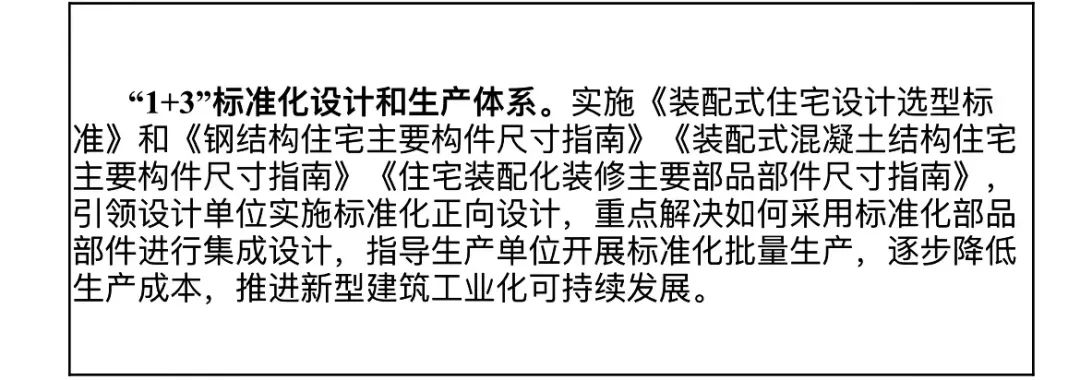
(7) Promote the promotion and application of green building materials.
Increase investment in research and development of green building materials products and key technologies, promote high-strength steel bars, high-performance concrete, high-performance masonry materials, structural insulation integrated wall panels, etc., and encourage the development of prefabricated components and parts with excellent performance. Take the lead in using green building materials in government investment projects, and significantly increase the proportion of green building materials in new urban buildings. Optimize the selection of materials to improve the health performance of buildings, carry out research on the integrated material selection technology of green building materials products to improve the use function of buildings, and promote new functional and environmentally friendly building materials products and supporting application technologies.
(8) Promote regional building energy synergy.
Promote the interaction between building energy use and energy supply, transmission and distribution response, and improve the overall efficiency of building energy use chain. We will carry out pilot demonstrations on the comprehensive utilization of low-grade waste heat in cities, coordinate and allocate waste heat from cogeneration, industry, nuclear power, waste incineration, recycled water and data centers, and other resources to meet the new heat supply needs of buildings in cities and surrounding areas. In the development and construction of new urban areas and functional areas, full consideration should be given to the surrounding energy supply conditions, renewable energy resources, and building energy demand, and regional building energy system planning, design and construction should be carried out to determine the demand and supply, and improve the comprehensive utilization efficiency of energy and the efficiency of energy infrastructure investment. Carry out the pilot of power demand response involving the whole group of buildings, actively participate in peak load and valley filling, cultivate a new model of smart energy use, and realize the smart response of building energy use and power supply. Promote the cooperative operation of source-network-charge-storage-use to enhance the system's capacity of peak regulation. We will accelerate the construction of electric vehicle charging and replacement infrastructure.
Box 9 Key Projects of Regional Building Energy Coordination

(九)We Will Promote Green City Development
We will carry out the construction of green and low-carbon cities and set a benchmark for green and low-carbon development of buildings. On the basis of full assessment of the current situation of energy and resource consumption and carbon emission of urban buildings, combined with the work of building energy conservation and green building, the implementation plan of green low-carbon city construction and green building special planning are formulated, the development goals and main tasks of green low-carbon city are clearly defined, and the green building grade and layout requirements of new civil buildings are determined. Promote the construction of green and low-carbon urban areas, achieve large-scale development of high-star green buildings, and promote the implementation of projects such as ultra-low-energy buildings, zero-carbon buildings, energy conservation and green transformation of existing buildings, renewable energy building applications, prefabricated buildings, and energy efficiency improvement of regional buildings, so as to comprehensively improve building energy conservation and green building development.
四、Safeguard Measure
(一)Improve The System of Regulations and Standards.
With the goal of green development of urban and rural construction and carbon peak carbon neutrality, promote the improvement of building energy efficiency and green building laws and regulations, implement the main responsibilities of all parties, and standardize and guide the healthy development of building energy efficiency and green buildings. We will guide local governments in formulating (revising) relevant local regulations and local government rules in light of their actual conditions. Improve the building energy efficiency and green building standards system, formulate (revise) zero-carbon building standards, green building design standards, green building project construction quality acceptance standards, building carbon emission accounting standards and other standards, the basic requirements of the Green Building Evaluation Standards into the full text of mandatory construction standards in the field of housing and urban and rural construction. We will implement standards such as the General Code for Building Energy Efficiency and Renewable Energy Utilization. Local governments are encouraged to develop higher levels of local standards for building energy efficiency and green buildings.
(二)Ensure the implementation of incentive policies.
Housing and urban and rural construction departments at all levels should strengthen communication with development and reform, finance and taxation departments, strive to implement support policies in terms of financial funds, prices and taxation, and give policy support to high-star green buildings, ultra-low energy consumption buildings, zero-carbon buildings, energy-saving renovation projects for existing buildings, renewable energy application projects for buildings, and green agricultural housing. We will work with relevant departments to promote the coordinated development of green finance and green buildings, innovate green financial products such as credit, and strengthen support for green insurance. We will improve government procurement requirements for green buildings and green building materials, and promote the application of green buildings and green building materials in government procurement. Explore the path of carbon emission trading for large buildings。
(三)Strengthen Institutional Development.
In accordance with the "Green Building identification Management Measures", the Ministry of Housing and Urban-Rural Development awarded the three-star green building identification, and the provincial housing and urban-rural construction department determined the two-star and one-star green building identification and awarding methods. Improve the national green building identification management system, and improve the efficiency of green building identification and filing. We will carry out trials of building energy efficiency evaluation and labeling, and gradually establish an energy efficiency evaluation and labeling system. The system of statistical reports on energy and resource consumption in civil buildings shall be regularly revised to enhance the accuracy, applicability and reliability of statistical data. Strengthen data sharing with water supply, power supply, gas supply, heat supply and other related industries, encourage the use of urban information model (CIM) basic platform, the establishment of urban smart energy management service system. Gradually establish and improve the contract energy management market mechanism, to provide energy-saving consulting, diagnosis, design, financing, transformation, hosting and other "one-stop" comprehensive services. Accelerate the implementation of green building materials product certification, establish and improve the green building materials credit mechanism, and promote the quality of building materials products.
(四)Highlight The Drive of Scientific and Technological Innovation.
Establish a market-oriented building energy efficiency and green building technology innovation system, organize key scientific research and project research in key areas, and promote the deep integration of the Internet, big data, artificial intelligence, advanced manufacturing with building energy efficiency and green buildings. Give full play to the role of the science and technology plan project platform of the Ministry of Housing and Urban-Rural Development, constantly optimize the project layout, and lead the direction of green building innovation development. Accelerate the transformation of building energy efficiency and green building scientific and technological innovation achievements, promote the integration of production, university research and application, create a collaborative innovation platform, and significantly increase the contribution rate of technological innovation to industrial development. Support and guide enterprises to develop building energy efficiency and green building equipment and products, cultivate building energy efficiency, green building, prefabricated building industry chains, and promote the integrated application of reliable technology and product equipment.
(五)Innovative Project Quality Supervision Model.
In the planning, design, construction, completion and acceptance stage, strengthen the supervision of the implementation of building energy efficiency and green building standards for new buildings, encourage the use of "Internet + supervision" approach, and improve supervision efficiency. The implementation of visual technology disclosure, through the establishment of a physical model in the construction site, unified process standards, standardize construction behavior. We will carry out trials of building energy efficiency and green building performance liability insurance, and use insurance measures to prevent and control quality risks at important nodes such as exterior insulation and indoor air quality.
五、Organization and Implementation
(一)Strengthen organizational leadership.
Local housing and urban and rural construction departments at all levels should attach great importance to building energy conservation and green building development work, under the leadership of local party committees and governments, improve the work coordination mechanism, formulate policies and measures, strengthen communication and coordination with development and reform, finance, finance and other departments, form a joint force, and jointly promote. The housing and urban and rural construction departments of all provinces (autonomous regions and municipalities) shall prepare special plans for building energy efficiency and green building development in their own regions, formulate key project plans, and submit the special plans to the Ministry of Housing and Urban and Rural Development before the end of September 2022.
(二)Strict Performance Appraisal
The implementation of building energy conservation and green building goals and tasks in various regions will be included in the annual inspection and assessment of the Ministry of Housing and Urban-Rural Development, and the completion of some planning goals and tasks will be included in the assessment and evaluation of carbon peaking carbon neutrality in urban and rural construction, dual control of "energy consumption" and green development of urban and rural construction. The Ministry of Housing and Urban-Rural Development organizes timely evaluation of the implementation of the plan. The housing and urban and rural construction departments of all provinces (autonomous regions and municipalities) shall submit their regional reports on building energy efficiency and green building development by the end of November each year.
(三)Intensive Publicity Training
All localities should mobilize all social forces, carry out various forms of building energy conservation and green building publicity activities, widely carry out building energy conservation and green building development news publicity, policy interpretation and education popularization for the public, and gradually form a general consensus of the whole society. Combined with activities such as energy-saving publicity Week, we actively advocate a simple, moderate, green and low-carbon lifestyle. Implement the building energy efficiency and green building training program, incorporate relevant knowledge into the key contents of professional and technical personnel's continuing education, encourage colleges and universities to add building energy efficiency and green building related courses, and train professional personnel.




 Shanghai ICP for 19000999-1
Shanghai ICP for 19000999-1